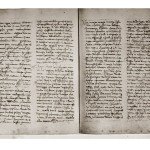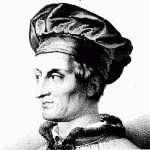How did one man’s voyage across the world culminate to “America?”
2012 marks the 500th anniversary of the death of Amerigo Vespucci – the Italian navigator whom the Western continents are named after. So, how did one man’s voyage across the world culminate to “America?”
by Erika BLOCK
Born on March 9, 1454 in Florence, Italy, Amerigo began his love affair with the uncharted early in life by collecting maps and immersing himself in books. His parents, wealthy silk traders, instilled in him the importance of education, where he learned the power of written words. Yet, instead of pursuing higher education like his elder brothers, Amerigo was hired as a clerk for the Medici family bank in Florence. In March 1492, Amerigo was transferred to a Medici bank branch in Cadiz, Spain after becoming confidants with Lorenzo de Medici, the new head of the family business.
Amerigo’s move to Spain could not have been more timely; the King and Queen of Spain had just approved to finance Christopher Columbus’ journey into the Atlantic. Upon Columbus’ return to Spain in March 1493, Amerigo grew skeptical of his declaration of reaching the south shores of Asia. Amerigo decided, then, that he, too, should venture west.
It is believed that Amerigo first departed from Spain in May 1497 where his crew sailed to Central America and continued northward to eventually discover Bermuda. The only documentation of the journey is a letter written to Piero Soderini, a statesman from Florence, detailing the customs of the native people. However, modern scholars question the voyage and authenticity of the letter altogether because of the lack of accurate recordings – Amerigo claimed to reach Central America without any sightings of islands, which is improbable considering his supposed route.
After returning to Spain in October 1498, Amerigo was determined to discover more pieces of a still-incomplete world-map. Thus, he joined Alonso de Ojeda in 1499, a Spanish navigator renowned for his efforts on Columbus’ 2nd voyage, in his expedition westward. The two intended to sail together in the Indian Ocean around the southern tip of Africa, but separated near Guyana when Ojeda hit land. Amerigo continued sailing until ultimately reaching South America. Upon arriving in Brazil, he found the mouth of the Amazon River, eventually earning him respect in Europe. Amerigo’s second noteworthy discovery on the voyage happened further north when he named the country Venezuela. He drew similarities between it’s tranquil bay and houses built over water to those of Venice; hence the name Venezuela, meaning Little Venice. In 1500, he made his way home through Hispaniola after passing Trinidad Island.
By now, Amerigo had earned a reputation as talented navigator, and was able to convince the King of Portugal to finance his third expedition. The three-ship crew departed from Lisbon in 1501 with an order to determine the status of Brazil’s independence as a nation.
After crossing the Atlantic Ocean in an impressive 64 days, Amerigo reached the Americas and followed the coastline south to Brazil. There, he discovered Rio de Janeiro and decided to set foot on the land to better observe the human inhabitants, flora and landscape. Because of his past education in Italy, Amerigo was able to communicate his findings through writing. He wrote letters to friends, including Lorenzo de Medici, confirming his original belief about the improbable likelihood that Columbus had reached Asia. The letters also included detailed descriptions of the indigenous peoples’ culture such as their eating habits, religious beliefs and, most striking, promiscuous actions (He found their sexual, marital and child birthing practices radical). Following his studying and journaling, Amerigo sailed further south until he found Rio de la Plata. Shortly after, he journeyed back home, concluding his last certain trip. Little is known of Amerigo’s fourth voyage except that he might have sailed back to the eastern shores of South America in 1503 and returned in 1504.
Even after covering such vast terrain, the question still remains: how did such an ambiguous figure come to name the Western half of the world?
The answer lies in the fate of Amerigo’s letters sent to Medici. After receiving the two letters, Medici published them under the title Mundus Novus (New World). They quickly gained popularity among readers because of their detailed descriptions of the “extreme” behavior of South America’s inhabitants and the declaration that Amerigo, in fact, had discovered a new world, not Columbus. The letters were translated into every European language and soon gained the attention of German cartographer Martin Waldseemuller. As it happened, his team was updating the world map at the time and grew fond of the idea of a new land beyond Columbus’ discoveries. In 1507, Waldseemuller published a world map and book entitled Cosmographiae Introductio with the name “America” on the southern continent of the New World. Waldseemuller later had second thoughts about the name, but the printed word was too powerful to take back.
Amerigo received the title “Pilot Major of Spain” in 1508 and died on February 22, 1512 without ever sailing again after his fourth voyage. A statue was made in his honor and is located outside of the Uffizi museum in Florence, Italy.
500 years later, controversy still remains over the validity of his letters and the amount he contributed while sailing. Nevertheless, Amerigo Vespucci will remain an important explorer whose name will never be forgotten.






